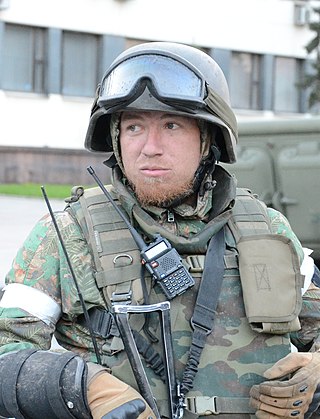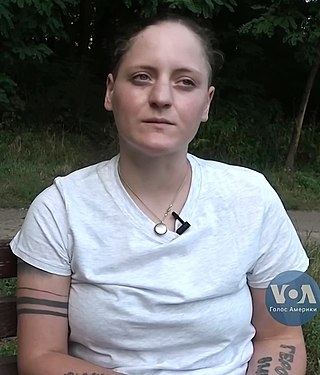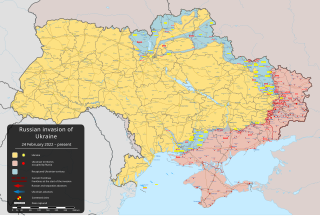Women in the military

The war has seen a significant increase in the number of women serving in the Ukrainian military, with several positions that had been reserved for men only being opened up to women. [5] [6] [7] By 2016, 8.5 percent of the Ukrainian military were women and by March 2021, the percentage of women in the Armed Forces had risen to 22.8 percent, 15.5% of them described by the Ukrainian Ministry of Defence as "service-personnel". [8] [9] [10] [11]
The Ukrainian Center for Drone Intelligence, which builds drones for the Ukrainian army and provides training courses for drone warfare, was founded by Maria Berlinska, who had volunteered to serve on the front after graduating from university. [12] [13]
A number of women soldiers have achieved high levels of public prominence during the war. Nadiya Savchenko, a fighter pilot who volunteered for the Aidar Battalion after her regular battalion was not deployed to the front, was named a Hero of Ukraine and elected to the Ukrainian Parliament after being captured by the Luhansk People's Republic. [14] [15] [16]
Women have also featured in military propaganda in the war. [17] In May 2014, Donetsk People's Republic Defence Minister Igor Girkin posted an online video calling for recruits, stating that "if men are not capable of this, we will have to call on women." [18] In March 2015, on International Women's Day, the DNR held a propaganda beauty pageant featuring all female soldiers. [19]
In their 2019 book Insurgent Women: Female Combatants in Civil Wars authors Darden, Henshaw and Szekely, while confirming the combat role of women in several Ukrainian and pro-Russian armed forces and militias as medics, drivers, sentries or on patrol, say that their participation in the first line of action, particularly as snipers, has been usually overstated by the media, or at least hard to verify. They distinguish female combatants by their motivation to become involved in the war. On the Ukrainian side, women were strongly moved by Ukrainian nationalism, while their pro-Russian counterpart fought for more personal reasons, like defending their families or homes. According to these authors, Ukrainian female soldiers actively chose "to go to the front. Those on the separatist side feel that the front came to them". [20]
Discrimination
Women in the Ukrainian military still face significant levels of discrimination and stigma, both formally, still being barred from a number of positions and with provisions like proper uniforms and maternity leave still lacking, and from their fellow soldiers. [21] Harassment and sexual violence against female soldiers is common and rarely reported or investigated. [22]
One female soldier recounted some of the discrimination she faced to Hromadske.TV: "I liberated 11 cities, I was involved in prisoner releases, but, nonetheless, most people would say that I am a “Carpathian, who fought in the first months of her pregnancy,” without taking my military experience into account." [23] According to the Atlantic Council:
Women served in both the Ukrainian military and volunteer battalions. In the process, they experienced sexual harassment on the frontlines and faced sexual discrimination upon their return home. Many women soldiers were criticized for leaving their children and families to serve, stereotyped as sexually promiscuous, or even investigated by social services and had their children taken away. The discrimination is often so bad that women veterans will not wear uniforms. Women are encouraged to ignore their trauma. As one female volunteer put it, “Men go to the pubs with other men, but women must get back to their jobs and take care of their children.” [24]
In July 2021, the Ukrainian military faced criticism after it announced that women soldiers would be marching in high heels in the parade marking 30 years of independence. [25] The Ukrainian Ministry of Defense stated that the military's 2017 dress code included high heels. [26]














